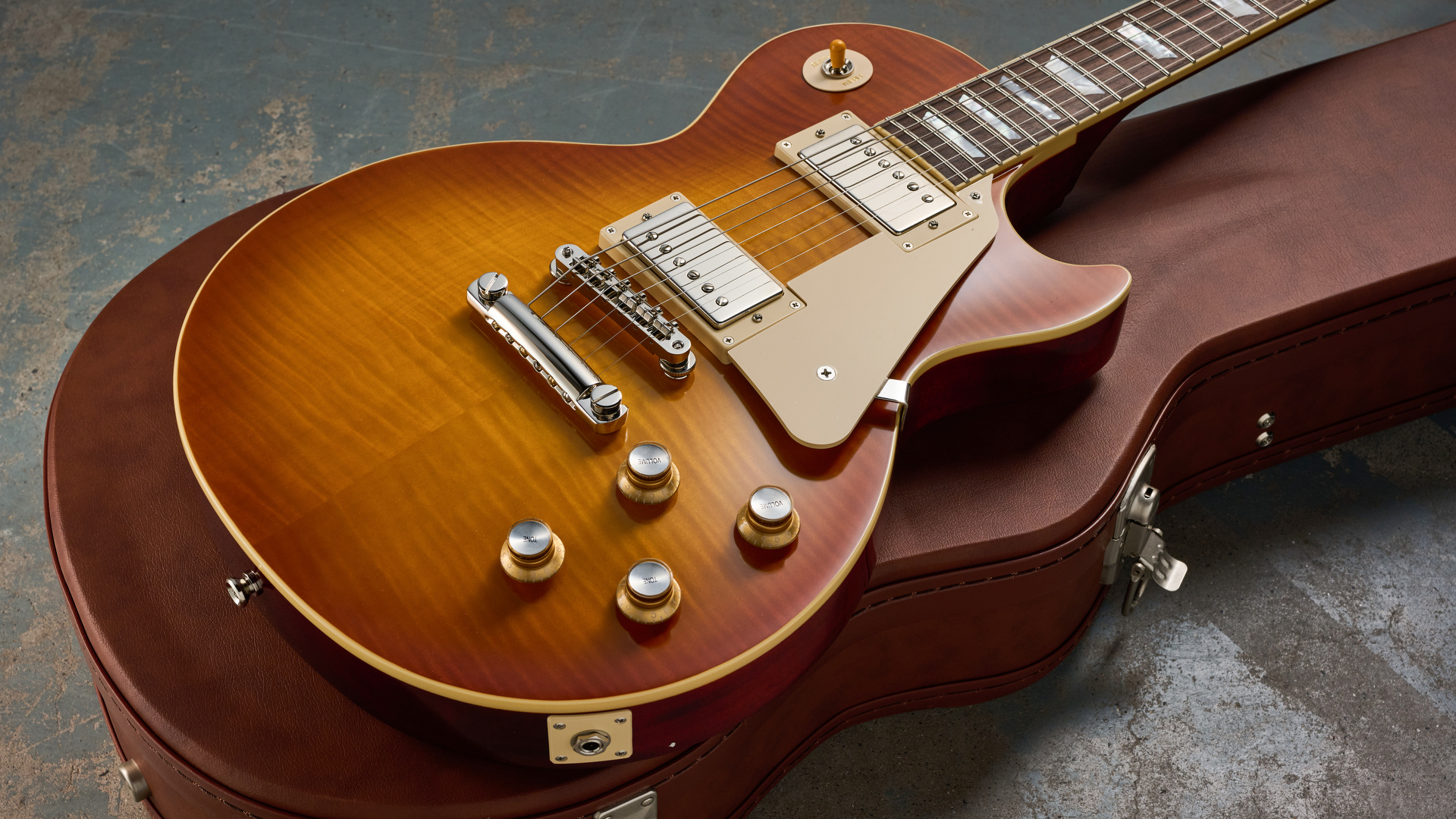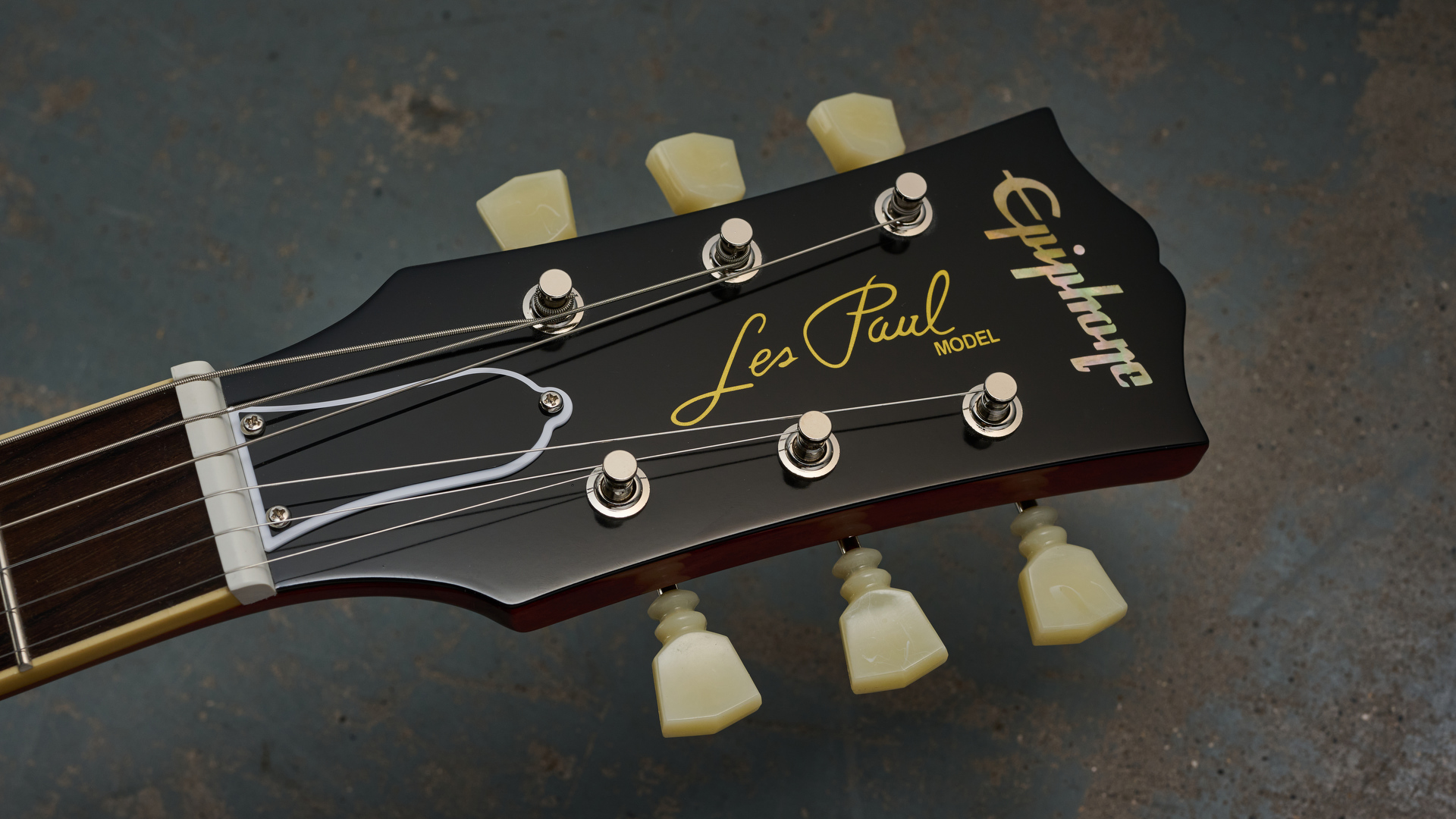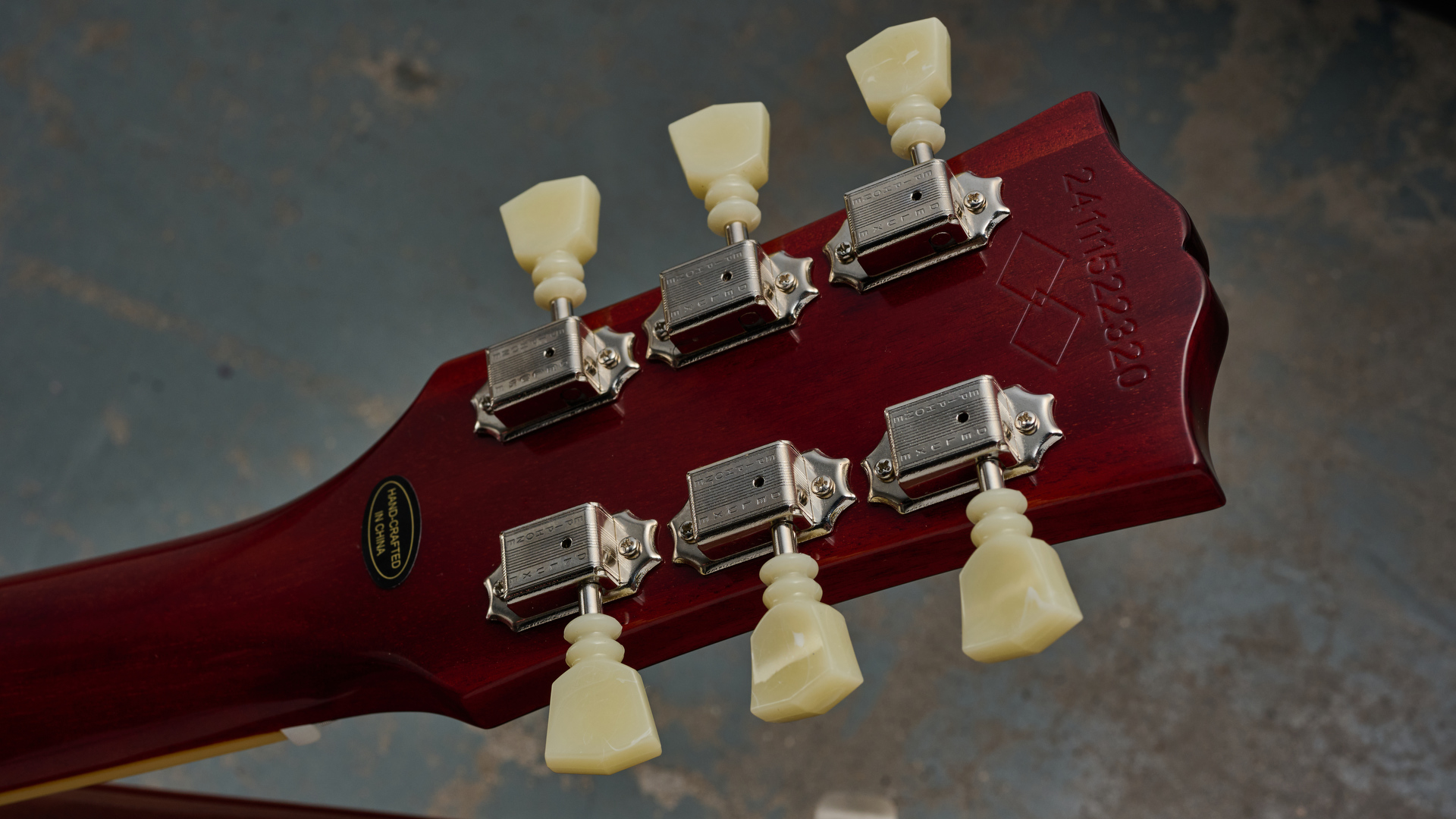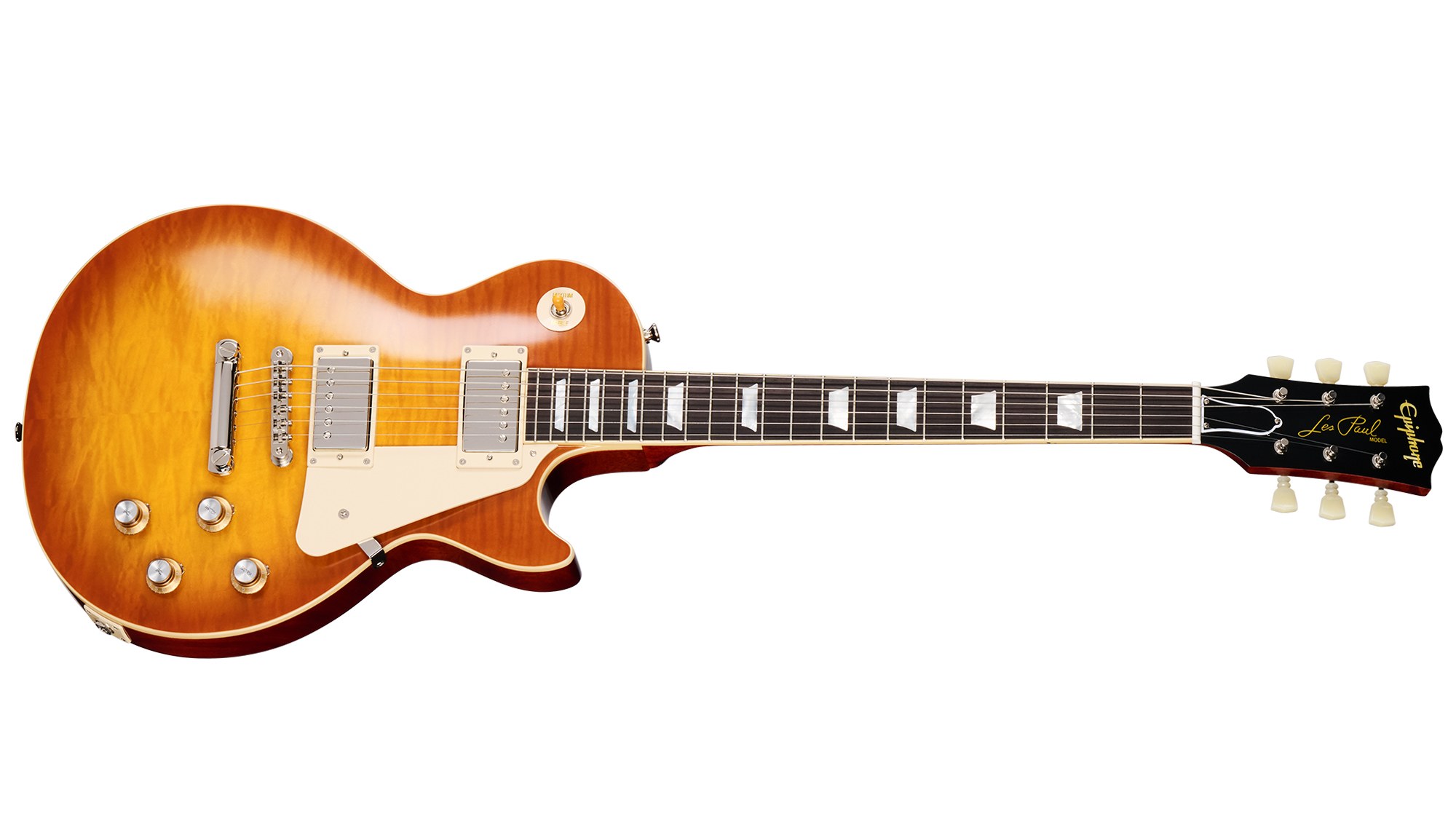
What is it?

Buying a Gibson guitar is something many guitarists dream of, and we’re certainly not buying it with value for money in mind. It’s an aspirational buy, something you get because let’s face it, there’s nothing quite as compelling as a good Les Paul, and fewer things still are as intoxicating as a 1960s one.
Of course, nobody reading this is likely to be able to afford the real deal, but that doesn’t mean we can’t get our hands on some of that magic mojo without the bourgeois budget. As evidenced by the Epiphone 1960 Les Paul Standard Reissue that’s the subject of this review, it’s actually more accessible than it’s ever been.
Made in conjunction with Gibson Custom, all of the staple specifications that make this a great Les Paul are here, with a genuine mahogany body and maple cap with AAA flamed maple veneer. The single ply cream binding lines the body, matching the pickguard and humbucker rings for a classic look.

The neck is a single piece of mahogany, with a long neck tenon for increased sustain, a characteristic of older LP and SG-type guitars. It features a rosewood fretboard with mother-of-pearl trapezoid inlays, and a SlimTaper neck profile typical of 60s Les Pauls. As with many of the new Epiphones, it also features the Gibson-style ‘open-book’ headstock design, further adding to its retro-LP credentials.
The electronics have a similarly period-correct feel to them too, with two Alnico 3 Gibson Custombuckers used on the Custom Shop’s Historic Reissue guitars for that classic PAF tone. Paper-in-oil capacitors, CTS potentiometers, and a Switchcraft pickup selector complete the classic lineup of separate volume and tone controls for the guitar.
As part of the package, you also get a brown Gibson Hardshell case with a rather fetching (or ugly depending on your perspective) pink plush interior to keep the guitar safe.
Specs

- Launch price: £1,199
- Made: China
- Type: Six-string electric guitar
- Body: Mahogany, with maple top and AAA flamed maple veneer
- Neck: Mahogany, 60s SlimTaper profile
- Fingerboard: Rosewood
- Scale length: 24.75”, 628.65mm
- Nut/width: Graph Tech, 43mm
- Frets: 22
- Hardware: Epiphone Deluxe tuners with Double Ring Keystone Buttons, ABR-1 Tune-O-Matic bridge with Historical Aluminium Tailpiece
- Electrics: 2x Gibson Custombuckers, 2 Volume, 2 Tone; CTS Potentiometers, Luxe Bumblebee Paper-in-Oil Capacitors
- Weight: 8lb 13oz / 3.68kg
- Left-handed options: No
- Finishes: Iced Tea Burst (as reviewed), Washed Cherry Sunburst Vintage Gloss
- Cases: Yes, Gibson Hardshell
- Contact: Epiphone
Build quality
Build quality rating: ★★★★☆
Getting the Epiphone Les Paul out of its case, my initial visual inspection turns up little to comment on. Apart from a slight over-application of gloss where the bass end of the neck and fretboard meet the body, everything looks in great condition. The extra protective layer of bubble wrap on the headstock was also appreciated to prevent any mishaps whilst it was being delivered.
Sitting it on my lap to give it a quick playthrough before plugging it in, I immediately notice that some of the fret ends were a little sharp on the bass end of the fingerboard. It doesn’t really get in the way that much as you’re playing, but it was noticeable and at this price point, I’d expect better. That small issue aside, it feels extremely well put together overall, and I can neither feel nor see any issues with the build quality.
Playability
Playability rating: ★★★★½
During my first playing test, I find the action to be set way too low out of the box and buzzing a lot on the bass strings. Although it makes for a fast-playing platform, it is at the expense of some of the sound.
It’s a beautiful playing neck, and kept me churning out lead licks for a long time with its addictive playability
The neck itself is very skinny in terms of profile, and as I usually play a 25.5-inch scale I find it quite cramped near the headstock, with my thumb naturally wanting to come over the top of the fretboard when playing there. Fretting chords is comfortable for the most part once I’d get over the initial adjustment phase, and with that low action barre chords are an absolute breeze to play even at the first fret.
It’s very shreddable for lead work, and the string gauge combined with the profile means that pentatonic licks fly off the fingerboard with haste when you start getting stuck into the faster stuff. It’s a beautiful playing neck, and kept me churning out lead licks for a long time with its addictive playability.
Channeling my inner Gary Moore with some huge bends is an incredibly satisfying feeling with this guitar, and it doesn't take me long to get them hitting accurately even when going for two whole tones with added vibrato. Everything feels buttery smooth on the rosewood ‘board, whether you’re knocking out hard rock riffs or going full-send on those fiery blues leads.
Sounds
Sounds rating: ★★★★½
As you might expect from a guitar so geared towards vintage-inspired playing, the pickups are decidedly smooth. No matter whether I was playing them through my tube amp or trying various amp models they remained extremely well behaved, delivering a glossy tone that remained articulate at all times.
Playing chords gives a lovely even balance across all of the strings even under ladles of distortion
The sustain is superb as you’d expect from an LP style guitar, and with a loud amp and a light dusting of gain from an overdrive pedal you can hit a note and it will ring out for days. Playing chords gives a lovely even balance across all of the strings even under ladles of distortion, and no matter where you go on the neck it always feels even and well balanced.
I do find that the pickups don’t perform as well as hotter humbucker LP examples I've tried when using some more ‘out there’ effects like synth pedals and my OBNE Beam Splitter, but I guess it’s to be expected that something so vintage-inspired isn’t going to do the job as well when you’re playing music that’s more futuristic. It certainly handles delay, reverb and other modulation tones well enough, even when I was plying it with exuberant amounts of effects.
I really enjoy the balance of the bridge and neck humbuckers too. There’s no noticeable jump in volume when switching from the bridge, to both on, and then to the neck position, with just a smooth change of the EQ balance apparent to me. It gives it a really natural feel when quickly changing pickup positions, so keeping the neck position a little cleaner for arpeggios before switching to the neck position for something gritter feels effortlessly smooth.
The pots here are a superb showcase of Les Paul versatility. The volume roll off is very usable, and you can go from completely clean to hugely saturated just in the sweep of either volume knob. That gives you a lot of scope even before you start adding pedals to your setup and channel switching on your amp.
Verdict
For us mere mortals that will never feel the fingerboard of a real vintage guitar, these reissues are the closest we’ll ever get and this Epiphone LP is a particularly accessible version of one of the most famous guitars ever made. If you’re all about getting as close as possible to period-correct as you can for this price point, then you won’t be disappointed here.
That said, and even with the range of its control tapers, it’s definitely not the most versatile instrument I’ve played. If you’re not playing music that’s vintage-inspired like the components of this guitar, you might find yourself a little limited by the low output pickups and slight imbalance of the body and neck weight. These are small niggles though, and I’m not expecting that players will be buying this guitar to play forward thinking post-punk on it.
MusicRadar: The word that I kept coming back to me when reviewing the Epiphone Inspired By Gibson Custom 1960 Les Paul Standard Reissue is ‘smooth’. From the pickup sound to the feel of the neck profile and fretboard combo, it’s an effortlessly playable guitar that delivers glassy guitar tones, and for those seeking those most famous of Les Paul guitar tones, it absolutely delivers.







